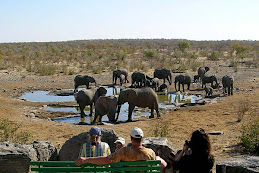Monday, May 11, 2009
News Blog
These shallow pans have no real river beds. As unusually heavy seasonal rains hit Namibia and neighbouring Angola earlier this year, the waters silently filled the oshanas.Once they were full, even more rain connected the oshanas to form vast shallow lakes stretching for kilometres and taking months to dry up.At least 102 people have died since January in the worst flooding since 1972, which has affected 600,000 people across northern Namibia.
Friday, May 8, 2009
Creative Writing Blog
Etosha’s silvery pan and surrounding plains in the north of the country teem with game, making
Wednesday, April 15, 2009
The Animals of Namibia
The "Big Cat"
Diet - The diet mainly consists of rodents, but they also eat birds, hares, reptiles, frogs and insects.
Colouring - The colouring is very similar to the domestic cat. The back of the ears, however, are orange-pink in colour.
Breeding - The female has a gestation period of 2 months and will then give birth to a litter of between 2 and 5 (mostly 3) kittens.
Size - The African Wild Cat can reach a shoulder height of 35 cm and can weight between 2.5 and 6 kg
The Black-Backed Jackal
Diet - insects, birds, rodents and occasionally small antelope.
Colouring - Light reddish brown. The 'saddle' on its back is black with white speckles. The tail is moderately bushy, fairly long, and sandy, marked with darker hairs, and usually with a dark tip.
Breeding - 1 - 6 (rarely 9) young are born from July - October after a gestation period of about 2 months.
Size - Shoulder height: 30 - 50cm and around 1m long (including a 30cm tail). Black backed jackals weigh up to 12kg
The Damara Dik Dik
Habitat - Dense woodland with thick shrub.
Diet - Because the dik-dik is so small, it needs to eat the most nutritious part of a plant which can include leaves, pods, flowers and occasionally sprouting grass.
Colouring - The back is grey-brown while the neck, shoulders and sides are browner. The chest and underparts are light compared to the rest of the body.
Breeding - The mother gives birth to one young a year after a gestation period of six months.
Size - The shoulder height is an average of 38 cm, wih a weight of 5kg.
Monday, April 13, 2009
Physical Features of Namibia
The magnificent Fish River Canyon and the eastern edge of the Namib Desert stretch north from the Orange River in the south and represent an area of stark beauty. The canyon is next in size to The Grand Canyon in North America, which makes it the worlds second largest. This southern and central interior region is a vast open expanse of grasslands and desert vegetation interspersed by stark mountains and isolated oasis where the presence of mainly subterranean water allows for cultivation of various crops. Moving further west towards the Botswana border the landscape changes into the vast sea of red sand and thorn trees of the Kalahari Desert that reaches far east across the entire land of Botswana. Here is another superb wilderness area of solitude and vast open wetlands teaming with wildlife and sparse human populations.
Thursday, April 9, 2009
Current History
Namibia’s history has passed through several stages from being colonized in the late 19th century to Namibia’s independence on March 21st 1990. Ever since 1884, Namibia has been a German colony. At the end of WW 1, the League of Nations mandated South Africa to administer territory. When WW 2 had begun, the League of Nations was dissolved in April 1946 and its successor, the US, instituted a trusteeship system to bring all of the former German colonies in Africa under the guidance of UN control. South Africa didn’t like this and that a majority of the territory's people were content with South African rule.

